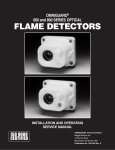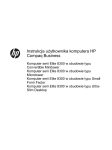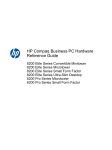Download HP RP3 Hardware Reference Manual
Transcript
Hardware Reference Guide HP RP3 Retail System Model 3100 © Copyright 2012 Hewlett-Packard Development Company, L.P. The information contained herein is subject to change without notice. The only warranties for HP products and services are set forth in the express warranty statements accompanying such products and services. Nothing herein should be construed as constituting an additional warranty. HP shall not be liable for technical or editorial errors or omissions contained herein. This document contains proprietary information that is protected by copyright. No part of this document may be photocopied, reproduced, or translated to another language without the prior written consent of Hewlett-Packard Company. Hardware Reference Guide HP RP3 Retail System Model 3100 First Edition (October 2012) Document Part Number: 704405-001 About This Book This guide provides basic information for upgrading this computer model. WARNING! Text set off in this manner indicates that failure to follow directions could result in bodily harm or loss of life. CAUTION: Text set off in this manner indicates that failure to follow directions could result in damage to equipment or loss of information. NOTE: Text set off in this manner provides important supplemental information. iii iv About This Book Table of contents 1 Product Features ............................................................................................................................................ 1 Standard Configuration Features ......................................................................................................... 1 Front Panel Components ..................................................................................................................... 2 Rear Panel Components ...................................................................................................................... 3 Serial Number Location ........................................................................................................................ 3 2 Hardware Upgrades ........................................................................................................................................ 4 Warnings and Cautions ........................................................................................................................ 4 Removing the Computer Access Panel ................................................................................................ 5 Replacing the Computer Access Panel ................................................................................................ 6 Removing the Front Bezel .................................................................................................................... 7 Replacing the Front Bezel .................................................................................................................... 8 System Board Connections .................................................................................................................. 8 Installing Memory ............................................................................................................................... 10 DDR3-SDRAM SODIMM ................................................................................................... 10 Replacing a SODIMM ........................................................................................................ 10 Installing an Expansion Card .............................................................................................................. 12 Installing an Optional Powered Serial Port Expansion Card .............................................. 13 Configuring Powered Serial Ports ...................................................................................... 16 Installing an Optional 12-Volt Powered USB Expansion Card ........................................... 17 Replacing the Riser Card ................................................................................................................... 20 Replacing the Hard Drive ................................................................................................................... 25 Replacing the Battery ......................................................................................................................... 29 Appendix A External Security Devices .......................................................................................................... 32 Installing a Security Lock .................................................................................................................... 32 HP Keyed Cable Lock ........................................................................................................ 32 Padlock .............................................................................................................................. 32 HP Business PC Security Lock .......................................................................................... 33 Front Bezel Security .......................................................................................................... 37 Appendix B Electrostatic Discharge .............................................................................................................. 39 Preventing Electrostatic Damage ....................................................................................................... 39 Grounding Methods ............................................................................................................................ 39 v Appendix C Computer Operating Guidelines, Routine Care and Shipping Preparation .......................... 40 Computer Operating Guidelines and Routine Care ............................................................................ 40 Shipping Preparation .......................................................................................................................... 40 Index ................................................................................................................................................................... 42 vi 1 Product Features Standard Configuration Features Features may vary depending on the model. For a complete listing of the hardware and software installed on the computer, run the diagnostic utility (included on some computer models only). Figure 1-1 Configuration NOTE: This product features optional Powered USB ports. In the retail industry, “Powered USB” is also referred to as “USB + Power,” “USB Plus Power,” and “Retail USB.” In this document, these ports are referred to as “Powered USB.” Standard Configuration Features 1 Front Panel Components Figure 1-2 Front Panel Components Table 1-1 Front Panel Components 1 Dual-State Power Button 5 USB Port 2 Power On Light 6 Hard Drive Activity Light 3 NIC Link Light 7 NIC Activity Light 4 Microphone Port 8 Headphone Port NOTE: The USB, microphone, and headphone ports are located behind a sliding door. The NIC link light indicates a network connection. The NIC activity light indicates network activity. The Power On Light is normally green when the power is on. If it is flashing red, there is a problem with the computer and it is displaying a diagnostic code. Refer to the Maintenance and Service Guide to interpret the code. 2 Chapter 1 Product Features Rear Panel Components Figure 1-3 Rear Panel Components Table 1-2 Rear Panel Components 1 Power Cord Connector 8 Cash Drawer Connector 2 Powered USB 24V 9 USB Ports (4) 3 RJ-45 Network Connector 10 Powered USB 12V 4 Expansion Slot Cover 11 VGA Connector 5 Parallel Port 12 DisplayPort 6 PS/2 Mouse Connector (green) 13 PS/2 Keyboard Connector (purple) 7 Serial Connector (COM1) 14 Serial Connector (COM2) NOTE: Arrangement and number of connectors may vary by model. The expansion slot can be populated with an optional 2-port serial card or an optional 3-port powered USB 12V card available from HP. The serial ports can be configured as 5V or 12V powered serial ports. CAUTION: You must peel off the metallic tape over the cash drawer connector to connect a cash drawer. The cash drawer connector is similar in size and shape to a telephone jack. To avoid damage to the computer, DO NOT plug a telephone cable into the cash drawer connector. Serial Number Location Each computer has a unique serial number and product ID number located on the back or side of the computer. Keep these numbers available for use when contacting customer service for assistance. Rear Panel Components 3 2 Hardware Upgrades Warnings and Cautions Before performing upgrades be sure to carefully read all of the applicable instructions, cautions, and warnings in this guide. WARNING! To reduce the risk of personal injury from electrical shock, hot surfaces, or fire: Disconnect the power cord from the wall outlet and allow the internal system components to cool before touching. Do not plug telecommunications or telephone connectors into the network interface controller (NIC) receptacles. Do not disable the power cord grounding plug. The grounding plug is an important safety feature. Plug the power cord in a grounded (earthed) outlet that is easily accessible at all times. To reduce the risk of serious injury, read the Safety & Comfort Guide. It describes proper workstation, setup, posture, and health and work habits for computer users, and provides important electrical and mechanical safety information. This guide is located on the Web at http://www.hp.com/ergo. WARNING! Energized and moving parts inside. Disconnect power to the equipment before removing the enclosure. Replace and secure the enclosure before re-energizing the equipment. CAUTION: Static electricity can damage the electrical components of the computer or optional equipment. Before beginning these procedures, ensure that you are discharged of static electricity by briefly touching a grounded metal object. See Electrostatic Discharge on page 39 for more information. When the computer is plugged into an AC power source, voltage is always applied to the system board. You must disconnect the power cord from the power source before opening the computer to prevent damage to internal components. 4 Chapter 2 Hardware Upgrades Removing the Computer Access Panel To access internal components, you must remove the access panel: 1. Remove/disengage any security devices that prohibit opening the computer. 2. Remove all removable media, such as USB flash drives, from the computer. 3. Turn off the computer properly through the operating system, then turn off any external devices. 4. Disconnect the power cord from the power outlet and disconnect any external devices. CAUTION: Regardless of the power-on state, voltage is always present on the system board as long as the system is plugged into an active AC outlet. You must disconnect the power cord to avoid damage to the internal components of the computer. 5. Loosen the thumbscrew on the rear of the computer (1), slide the access panel toward the rear of the computer, then lift it off (2). Figure 2-1 Removing the Computer Access Panel Removing the Computer Access Panel 5 Replacing the Computer Access Panel 1. Align the tabs on the panel with the slots on the chassis then slide the panel towards the front of the chassis until it stops (1). 2. Tighten the thumbscrew to secure the access panel (2). Figure 2-2 Replacing the Computer Access Panel 6 Chapter 2 Hardware Upgrades Removing the Front Bezel NOTE: The front bezel does not need to be removed for any of the procedures in this guide. It only needs to be removed if you are replacing the bezel or replacing the speaker or front I/O. 1. Remove/disengage any security devices that prohibit opening the computer. 2. Remove all removable media, such as USB flash drives, from the computer. 3. Turn off the computer properly through the operating system, then turn off any external devices. 4. Disconnect the power cord from the power outlet and disconnect any external devices. CAUTION: Regardless of the power-on state, voltage is always present on the system board as long as the system is plugged into an active AC outlet. You must disconnect the power cord to avoid damage to the internal components of the computer. 5. Remove the computer access panel. 6. Lift up the three tabs on the side of the bezel (1), then rotate the bezel off the chassis (2). Figure 2-3 Removing the Front Bezel Removing the Front Bezel 7 Replacing the Front Bezel Insert the three hooks on the bottom side of the bezel into the rectangular holes on the chassis (1) then rotate the top side of the bezel onto the chassis (2) and snap it into place. Figure 2-4 Replacing the Front Bezel System Board Connections Refer to the following illustration and table to identify the system board connectors. Figure 2-5 System Board Connections 8 No. System Board Connector System Board Label Color Component 1 USB MEDIA2 black 12-volt Powered USB Card 2 USB MEDIA1 green 12-volt Powered USB Card Chapter 2 Hardware Upgrades No. System Board Connector System Board Label Color Component 3 Riser Card Socket RPOS RISER white Riser Card 4 Memory Socket DIMM1 black Memory 5 SATA 3.0 SATA0 dark blue Hard Drive 6 Battery Holder BAT black Battery 7 Mini PCI Express x1 X1PCIEXP1 black Expansion Card (for example, WLAN card) System Board Connections 9 Installing Memory The computer comes with one double data rate 3 synchronous dynamic random access memory (DDR3-SDRAM) small outline dual inline memory module (SODIMM). DDR3-SDRAM SODIMM CAUTION: This product DOES NOT support DDR3 Ultra Low Voltage (DDR3U) memory. The processor is not compatible with DDR3U memory and if you plug DDR3U memory into the system board, it can cause the physical damage to the SODIMM or invoke system malfunction. For proper system operation, the SODIMM must be: ● industry-standard 204-pin ● unbuffered non-ECC PC3-12800 DDR3-1600 MHz-compliant ● 1.5 volt DDR3-SDRAM SODIMMs The DDR3-SDRAM SODIMM must also: ● support CAS latency 11 DDR3 1600 MHz (11-11-11 timing) ● contain the mandatory Joint Electronic Device Engineering Council (JEDEC) specification In addition, the computer supports: ● 512-Mbit, 1-Gbit, and 2-Gbit non-ECC memory technologies ● single-sided and double-sided SODIMMS ● SODIMMs constructed with x8 and x16 devices; SODIMMs constructed with x4 SDRAM are not supported NOTE: The system will not operate properly if you install an unsupported SODIMM. Replacing a SODIMM CAUTION: You must disconnect the power cord and wait approximately 30 seconds for the power to drain before removing or installing a memory module. Regardless of the power-on state, voltage is always supplied to the memory module as long as the computer is plugged into an active AC outlet. Removing or installing a memory module while voltage is present may cause irreparable damage to the memory module or system board. The memory module socket has gold-plated metal contacts. When upgrading the memory, it is important to use a memory module with gold-plated metal contacts to prevent corrosion and/or oxidation resulting from having incompatible metals in contact with each other. Static electricity can damage the electronic components of the computer or optional cards. Before beginning these procedures, ensure that you are discharged of static electricity by briefly touching a grounded metal object. For more information, refer to Electrostatic Discharge on page 39. When handling a memory module, be careful not to touch any of the contacts. Doing so may damage the module. 10 1. Remove/disengage any security devices that prohibit opening the computer. 2. Remove all removable media, such as USB flash drives, from the computer. 3. Turn off the computer properly through the operating system, then turn off any external devices. Chapter 2 Hardware Upgrades 4. Disconnect the power cord from the power outlet and disconnect any external devices. CAUTION: You must disconnect the power cord and wait approximately 30 seconds for the power to drain before removing or installing a memory module. Regardless of the power-on state, voltage is always supplied to the memory module as long as the computer is plugged into an active AC outlet. Removing or installing a memory module while voltage is present may cause irreparable damage to the memory module or system board. 5. Remove the computer access panel. WARNING! To reduce risk of personal injury from hot surfaces, allow the internal system components to cool before touching. 6. To remove a SODIMM, press outward on the two latches on each side of the SODIMM (1) then pull the SODIMM out of the socket (2). Figure 2-6 Removing a SODIMM Installing Memory 11 7. Slide the new SODIMM into the socket at approximately a 30° angle (1) then press the SODIMM down (2) so that the latches lock it in place. Figure 2-7 Installing a SODIMM NOTE: A memory module can be installed in only one way. Match the notch on the module with the tab on the memory socket. 8. Replace the access panel. 9. Reconnect the power cord and turn on the computer. 10. Lock any security devices that were disengaged when the access panel was removed. The computer automatically recognizes the additional memory when you turn on the computer. Installing an Expansion Card One Full-height expansion card can be installed into one of the riser card slots on the computer. There are two riser cards available from HP for this product. One has a PCI slot and the other has a PCI Express x1 slot. Both cards have a slot designated for the Powered Serial Port expansion card. CAUTION: The Powered Serial Port expansion card slot on the riser card looks very similar to a PCI Express x1 expansion card slot. Do not attempt to insert a PCI Express x1 expansion card into the Powered Serial Port expansion card slot and do not attempt to insert a Powered Serial Port expansion card into a PCI Express x1 expansion card slot Figure 2-8 Riser Card Configurations 12 Chapter 2 Hardware Upgrades Table 2-1 Riser Card Configurations No. Expansion Slots 1 PCI Express x1 Expansion Card slot 2 PCI Expansion Card slot 3 Powered Serial Port Expansion Card slot NOTE: Although there are two slots in each riser card, you can only install one expansion card in the riser card. The bottom slot on each card (3) is designed specifically for an HP Powered Serial Port expansion card. DO NOT attempt to plug any other type of card into the bottom slot. Installing an Optional Powered Serial Port Expansion Card Two powered serial ports, COM 1 and COM 2, are standard on the computer. Some models have a powered serial port expansion card installed that supplies two additional powered serial ports, COM 3 and COM 4. If your computer is not configured with a powered serial port expansion card, you may purchase one from HP. Figure 2-9 Powered Serial Ports Table 2-2 Powered Serial Ports Item Description Supports +5V +12V 1 COM 1 Yes Yes 2 COM 2 Yes Yes 3 COM 3 (optional) Yes Yes 4 COM 4 (optional) Yes Yes NOTE: The powered serial ports are configured for power in the Computer Setup utility. Refer to Configuring Powered Serial Ports on page 16 for more information. CAUTION: Be careful when connecting peripheral devices to powered 5V and 12V serial ports. The peripheral device must require the same voltage for which the powered serial port is configured. Connecting a peripheral device that is not rated for the same voltage supplied by the powered serial port can damage the computer and the peripheral device. Installing an Expansion Card 13 If the powered serial ports have been configured for power from the factory, they will be covered by protective plastic caps. Turn off the computer and remove the caps before connecting powered serial devices. To install a Powered Serial Port expansion card: NOTE: The following procedure provides instructions for installing a Powered Serial Port expansion card. However, the procedure is basically the same for installing any full-height PCI expansion card or PC Express x1 expansion card. 1. Remove/disengage any security devices that prohibit opening the computer. 2. Remove all removable media, such as USB flash drives, from the computer. 3. Turn off the computer properly through the operating system, then turn off any external devices. 4. Disconnect the power cord from the power outlet and disconnect any external devices. CAUTION: Regardless of the power-on state, voltage is always present on the system board as long as the system is plugged into an active AC outlet. You must disconnect the power cord to avoid damage to the internal components of the computer. 5. Remove the computer access panel. 6. Push outward on the tab located on the back of the expansion card retention latch inside the chassis (1) and rotate the latch open (2). Figure 2-10 Opening the Slot Cover Retention Latch 14 Chapter 2 Hardware Upgrades 7. Before installing the expansion card, remove the expansion slot cover by sliding it out of the slot on the rear of the chassis. Figure 2-11 Removing an Expansion Slot Cover 8. Install the Powered Serial Port expansion card into the bottom socket on the riser card. Move the card toward the rear of the chassis so that the bracket on the card is aligned with the open slot on the rear of the chassis (1). Press the card straight down into the expansion socket on the riser card (2). NOTE: The Powered Serial Port expansion card must be installed in the bottom socket on the riser card. The bottom socket is designed specifically for that card. DO NOT attempt to install any other card in the bottom socket. Figure 2-12 Installing the Powered Serial Port Expansion Card in the Riser Card Installing an Expansion Card 15 9. Close the expansion card retention latch. Figure 2-13 Closing the Expansion Card Retention Latch 10. Replace the computer access panel. 11. Reconnect the power cord and any external devices, then turn on the computer. 12. Lock any security devices that were disengaged when the access panel was removed. 13. Reconfigure the computer, if necessary. Configuring Powered Serial Ports The serial ports can be configured as standard (non-powered) serial ports or powered serial ports. Some devices use a powered serial port. If the serial port is configured as a powered port, devices that support a powered serial interface do not require an external power source. NOTE: The computer ships with all serial ports configured in standard serial mode by default unless the powered serial port AV numbers are ordered. The serial ports can be configured using the Computer F10 Setup utility. Under the Onboard Devices menu, you are given the option to select the following three settings for each individual serial port (port A, B, if available C, and D): ● Standard ● 5v on pins 1 and 9 ● 12v on pins 1 and 9 NOTE: To access the Computer F10 Setup utility, restart the computer and press the F10 key as soon as the HP logo screen is displayed (before the computer boots to the operating system). CAUTION: Be careful when connecting peripheral devices to powered 5V and 12V serial ports. The peripheral device must require the same voltage for which the powered serial port is configured. Connecting a peripheral device that is not rated for the same voltage supplied by the powered serial port can damage the computer and the peripheral device. 16 Chapter 2 Hardware Upgrades Installing an Optional 12-Volt Powered USB Expansion Card The computer is equipped with a 24-volt Powered USB connector on the riser card and one 12-volt Powered USB connector on the system board. It may also have an optional 12-volt Powered USB expansion card installed with three extra 12-volt Powered USB ports. The 24-volt Powered USB connector and the 12-volt Powered USB connector are keyed differently as a precaution to prevent connection errors. Figure 2-14 24-volt and 12-volt Powered USB Connectors Table 2-3 24-volt and 12-volt Powered USB Connectors No. Connector Color 1 24-volt Powered USB Red 2 12-volt Powered USB Teal The 12-volt Powered USB expansion card must be installed in the PCI Express x1 expansion socket on the riser card. If your riser card does not have a PCI Express x1 expansion socket, you can replace the riser card with one that does have a PCI Express x1 expansion socket. Refer to Replacing the Riser Card on page 20 for more information. To install a 12-volt Powered USB expansion card: 1. Remove/disengage any security devices that prohibit opening the computer. 2. Remove all removable media, such as USB flash drives, from the computer. 3. Turn off the computer properly through the operating system, then turn off any external devices. 4. Disconnect the power cord from the power outlet and disconnect any external devices. CAUTION: Regardless of the power-on state, voltage is always present on the system board as long as the system is plugged into an active AC outlet. You must disconnect the power cord to avoid damage to the internal components of the computer. 5. Remove the computer access panel. 6. Locate the PCI Express x1 expansion socket on the riser card. The Powered USB expansion card must be installed in the PCI Express x1 expansion socket. Installing an Expansion Card 17 7. Push outward on the tab located on the back of the expansion card retention latch inside the chassis (1) and rotate the latch open (2). Figure 2-15 Opening the Slot Cover Retention Latch 8. Before installing the expansion card, remove the expansion slot cover by sliding it out of the slot on the rear of the chassis. Figure 2-16 Removing an Expansion Slot Cover 18 Chapter 2 Hardware Upgrades 9. Install the Powered USB expansion card into the PCI Express x1 socket on the riser card. Move the card toward the rear of the chassis so that the bracket on the card is aligned with the open slot on the rear of the chassis (1). Press the card straight down into the expansion socket on the riser card (2). Figure 2-17 Installing the Powered USB Expansion Card in the Riser Card 10. The cable included with the card has a single connector on one end and dual connectors on the other end. All three connectors are keyed to ensure proper connection. Connect the single end of the cable to the rear of the card (1). Connect the green connector on the other end of the cable to the green USB connector on the system board (2). Connect the black cable connector to the black USB connector on the system board (3). NOTE: The green USB connector on the system board has two rows of pins. You can attach the green cable from the card to either row. Figure 2-18 Connecting the 12-volt Powered USB Cable Installing an Expansion Card 19 11. Close the expansion card retention latch. Figure 2-19 Closing the Expansion Card Retention Latch 12. Replace the computer access panel. 13. Reconnect the power cord and any external devices, then turn on the computer. 14. Lock any security devices that were disengaged when the access panel was removed. 15. Reconfigure the computer, if necessary. Replacing the Riser Card There are two riser cards available from HP for this product. One has a PCI slot and the other has a PCI Express x1 slot. Both cards have a slot designated for the Powered Serial Port expansion card. You can purchase either card as a replacement from HP. To replace the riser card: 1. Remove/disengage any security devices that prohibit opening the computer. 2. Remove all removable media, such as USB flash drives, from the computer. 3. Turn off the computer properly through the operating system, then turn off any external devices. 4. Disconnect the power cord from the power outlet and disconnect any external devices. CAUTION: Regardless of the power-on state, voltage is always present on the system board as long as the system is plugged into an active AC outlet. You must disconnect the power cord to avoid damage to the internal components of the computer. 5. 20 Remove the computer access panel. Chapter 2 Hardware Upgrades 6. If an expansion card is installed in one of the riser card expansion slots, push outward on the tab located on the back of the expansion card retention latch inside the chassis (1) and rotate the latch open (2). Figure 2-20 Opening the Slot Cover Retention Latch 7. If an expansion card is installed in one of the riser card expansion slots, remove the card. Figure 2-21 Removing an Expansion Card Replacing the Riser Card 21 8. To remove the riser card, pull back the arm on the back of the riser card socket (1), then lift the riser card out of the riser card socket (2). Figure 2-22 Removing the Riser Card 9. To install the new riser card, press the riser card firmly down into the riser card socket on the system board. Make sure that the tab on the end of the riser card bracket seats into the slot on the chassis when installing the card. Figure 2-23 Installing the Riser Card 22 Chapter 2 Hardware Upgrades 10. If an expansion card was removed from the old riser card or you are installing a new expansion card into the riser card, install the card into the appropriate slot on the new riser card. Move the card toward the rear of the chassis so that the bracket on the card is aligned with the open slot on the rear of the chassis (1). Press the card straight down into the expansion socket on the riser card (2). Figure 2-24 Installing an Expansion Card in the Riser Card 11. If an expansion card was removed from the old riser card and you are not replacing the expansion card, install a slot cover in the expansion slot. CAUTION: After removing an expansion card, you must replace it with a new card or expansion slot cover for proper cooling of internal components during operation. Figure 2-25 Installing an Expansion Slot Cover Replacing the Riser Card 23 12. Close the expansion card retention latch if it is open. Figure 2-26 Closing the Expansion Card Retention Latch 13. Replace the computer access panel. 14. Reconnect the power cord and any external devices, then turn on the computer. 15. Lock any security devices that were disengaged when the access panel was removed. 24 Chapter 2 Hardware Upgrades Replacing the Hard Drive NOTE: The HP RP3 computer supports 2.5-inch Serial ATA (SATA) internal hard drives. Before you remove the old hard drive, be sure to back up the data from the old hard drive so that you can transfer the data to the new hard drive. The 2.5-inch hard drive is enclosed in a carrier on the interior of the front panel. To replace the drive: 1. Remove/disengage any security devices that prohibit opening the computer. 2. Remove all removable media, such as USB flash drives, from the computer. 3. Turn off the computer properly through the operating system, then turn off any external devices. 4. Disconnect the power cord from the power outlet and disconnect any external devices. CAUTION: Regardless of the power-on state, voltage is always present on the system board as long as the system is plugged into an active AC outlet. You must disconnect the power cord to avoid damage to the internal components of the computer. 5. Remove the computer access panel. 6. Disconnect the cables from the rear of the hard drive. Figure 2-27 Disconnecting the Hard Drive Cables Replacing the Hard Drive 25 7. Press outward on the release latch located on the front panel just above the cable connection on the hard drive (1), then slide the carrier toward the center of the chassis and pull the carrier straight back from the front panel to remove it (2). Figure 2-28 Removing the Hard Drive Carrier 8. Press the retention arm on the rear of the carrier outward (1), then slide the drive forward and lift it out of the carrier (2). Figure 2-29 Removing the Hard Drive from the Carrier 26 Chapter 2 Hardware Upgrades 9. Remove the four mounting screws from the sides of the hard drive. Figure 2-30 Removing the Mounting Screws 10. Install the four mounting screws on the sides of the new hard drive. Figure 2-31 Installing the Mounting Screws Replacing the Hard Drive 27 11. To install the hard drive in the carrier, align the mounting screws with the slots on the carrier, press the drive straight down into the carrier, then slide the drive back so that it locks inside the carrier. Ensure that the drive is properly seated in the carrier with the retention arm all the way down in the locked position. Figure 2-32 Installing the Hard Drive in the Carrier 12. To place the hard drive carrier back in the chassis, align the mounting screws with the slots on the top and bottom of the chassis then press the carrier against the rear panel and slide the drive toward the outside of the chassis until it locks in place. Figure 2-33 Installing the Hard Drive Carrier 28 Chapter 2 Hardware Upgrades 13. Connect the drive cables to the rear of the hard drive. Figure 2-34 Connecting the Hard Drive Cables 14. Replace the computer access panel. 15. Reconnect the power cord and turn on the computer. 16. Lock any security devices that were disengaged when the computer cover or access panel was removed. NOTE: No configuration of the SATA hard drive is necessary; the computer automatically recognizes it the next time you turn on the computer. Replacing the Battery The battery that comes with the computer provides power to the real-time clock. When replacing the battery, use a battery equivalent to the battery originally installed in the computer. The computer comes with a 3-volt lithium coin cell battery. WARNING! The computer contains an internal lithium manganese dioxide battery. There is a risk of fire and burns if the battery is not handled properly. To reduce the risk of personal injury: Do not attempt to recharge the battery. Do not expose to temperatures higher than 60°C (140ºF). Do not disassemble, crush, puncture, short external contacts, or dispose of in fire or water. Replace the battery only with the HP spare designated for this product. CAUTION: Before replacing the battery, it is important to back up the computer CMOS settings. When the battery is removed or replaced, the CMOS settings will be cleared. Static electricity can damage the electronic components of the computer or optional equipment. Before beginning these procedures, ensure that you are discharged of static electricity by briefly touching a grounded metal object. Replacing the Battery 29 NOTE: The lifetime of the lithium battery can be extended by plugging the computer into a live AC wall socket. The lithium battery is only used when the computer is NOT connected to AC power. HP encourages customers to recycle used electronic hardware, HP original print cartridges, and rechargeable batteries. For more information about recycling programs, go to http://www.hp.com/ recycle. 1. Remove/disengage any security devices that prohibit opening the computer. 2. Remove all removable media, such as USB flash drives, from the computer. 3. Turn off the computer properly through the operating system, then turn off any external devices. 4. Disconnect the power cord from the power outlet and disconnect any external devices. CAUTION: Regardless of the power-on state, voltage is always present on the system board as long as the system is plugged into an active AC outlet. You must disconnect the power cord to avoid damage to the internal components of the computer. 5. Remove the computer access panel. 6. Locate the battery and battery holder on the system board. 7. Depending on the type of battery holder on the system board, complete the following instructions to replace the battery. Type 1 a. To release the battery from its holder, insert a thin metal instrument into the slot on the side of the holder below the battery (1) and pry the battery up and out of the holder (2). b. To insert the new battery, slide one edge of the replacement battery under the holder’s lip with the positive side up (1) and press the other edge down into the holder so that it snaps in place (2). Figure 2-35 Removing and Replacing a Coin Cell Battery (Type 1) Type 2 a. 30 To release the battery from its holder, squeeze the metal clamp that extends above one edge of the battery. When the battery pops up, lift it out (1). Chapter 2 Hardware Upgrades b. To insert the new battery, slide one edge of the replacement battery under the holder’s lip with the positive side up. Push the other edge down until the clamp snaps over the other edge of the battery (2). Figure 2-36 Removing and Replacing a Coin Cell Battery (Type 2) NOTE: After the battery has been replaced, use the following steps to complete this procedure. 8. Replace the computer access panel. 9. Reconnect the power cord and any external devices, then turn on the computer. 10. Reset the date and time, your passwords, and any special system setups using Computer Setup. 11. Lock any security devices that were disengaged when the computer access panel was removed. Replacing the Battery 31 A External Security Devices Installing a Security Lock The security locks displayed below and on the following pages can be used to secure the computer. HP Keyed Cable Lock Figure A-1 Installing a Cable Lock Padlock Figure A-2 Installing a Padlock 32 Appendix A External Security Devices HP Business PC Security Lock 1. Fasten the security cable by looping it around a stationary object. Figure A-3 Securing the Cable to a Fixed Object 2. Insert the cable lock into the cable lock slot on the back of the monitor and secure the lock to the monitor by inserting the key into the key hole on the rear of the lock and rotating the key 90 degrees. Figure A-4 Installing the Cable Lock on the Monitor Installing a Security Lock 33 3. Slide the security cable through the hole in the cable lock on the rear of the monitor. Figure A-5 Securing the Monitor 4. Use the bracket provided in the kit to secure other peripheral devices by laying the device cable across the center of the bracket (1) and inserting the security cable through one of the two holes in the bracket (2). Use the hole in the bracket that best secures the peripheral device cable. Figure A-6 Securing Peripheral Devices (Printer Shown) 34 Appendix A External Security Devices 5. Thread the keyboard and mouse cables through the computer chassis lock. Figure A-7 Threading the Keyboard and Mouse Cables 6. Screw the lock to the rear of the chassis using the screw provided. Figure A-8 Attaching the Lock to the Chassis Installing a Security Lock 35 7. Insert the plug end of the security cable into the lock (1) and push the button in (2) to engage the lock. Use the key provided to disengage the lock. Figure A-9 Engaging the Lock 8. When complete, all devices in your workstation will be secured. Figure A-10 Secured Workstation 36 Appendix A External Security Devices Front Bezel Security The front bezel can be locked in place by installing a security screw provided by HP. To install the security screw: 1. Remove/disengage any security devices that prohibit opening the computer. 2. Remove all removable media, such as USB flash drives, from the computer. 3. Turn off the computer properly through the operating system, then turn off any external devices. 4. Disconnect the power cord from the power outlet and disconnect any external devices. CAUTION: Regardless of the power-on state, voltage is always present on the system board as long as the system is plugged into an active AC outlet. You must disconnect the power cord to avoid damage to the internal components of the computer. 5. Remove the computer access panel. 6. Remove the silver security screw located on top of the fan shroud. Figure A-11 Retrieving the Front Bezel Security Screw Installing a Security Lock 37 7. Install the security screw through the middle front bezel release tab to secure the front bezel to the chassis. Figure A-12 Installing the Front Bezel Security Screw 8. Replace the access panel. 9. Reconnect the power cord and any external devices, then turn on the computer. 10. Lock any security devices that were disengaged when the access panel was removed. 38 Appendix A External Security Devices B Electrostatic Discharge A discharge of static electricity from a finger or other conductor may damage system boards or other static-sensitive devices. This type of damage may reduce the life expectancy of the device. Preventing Electrostatic Damage To prevent electrostatic damage, observe the following precautions: ● Avoid hand contact by transporting and storing products in static-safe containers. ● Keep electrostatic-sensitive parts in their containers until they arrive at static-free workstations. ● Place parts on a grounded surface before removing them from their containers. ● Avoid touching pins, leads, or circuitry. ● Always be properly grounded when touching a static-sensitive component or assembly. Grounding Methods There are several methods for grounding. Use one or more of the following methods when handling or installing electrostatic-sensitive parts: ● Use a wrist strap connected by a ground cord to a grounded workstation or computer chassis. Wrist straps are flexible straps with a minimum of 1 megohm +/- 10 percent resistance in the ground cords. To provide proper ground, wear the strap snug against the skin. ● Use heelstraps, toestraps, or bootstraps at standing workstations. Wear the straps on both feet when standing on conductive floors or dissipating floor mats. ● Use conductive field service tools. ● Use a portable field service kit with a folding static-dissipating work mat. If you do not have any of the suggested equipment for proper grounding, contact an HP authorized dealer, reseller, or service provider. NOTE: For more information on static electricity, contact an HP authorized dealer, reseller, or service provider. Preventing Electrostatic Damage 39 C Computer Operating Guidelines, Routine Care and Shipping Preparation Computer Operating Guidelines and Routine Care Follow these guidelines to properly set up and care for the computer and monitor: ● Keep the computer away from excessive moisture, direct sunlight, and extremes of heat and cold. ● Operate the computer on a sturdy, level surface. Leave a 10.2-cm (4-inch) clearance on all vented sides of the computer and above the monitor to permit the required airflow. ● Never restrict the airflow into the computer by blocking any vents or air intakes. Do not place the keyboard, with the keyboard feet down, directly against the front of the desktop unit as this also restricts airflow. ● Never operate the computer with the access panel or any of the expansion card slot covers removed. ● Do not stack computers on top of each other or place computers so near each other that they are subject to each other’s re-circulated or preheated air. ● If the computer is to be operated within a separate enclosure, intake and exhaust ventilation must be provided on the enclosure, and the same operating guidelines listed above will still apply. ● Keep liquids away from the computer and keyboard. ● Never cover the ventilation slots on the monitor with any type of material. ● Install or enable power management functions of the operating system or other software, including sleep states. ● Turn off the computer before you do either of the following: ◦ Wipe the exterior of the computer with a soft, damp cloth as needed. Using cleaning products may discolor or damage the finish. ◦ Occasionally clean the air vents on all vented sides of the computer. Lint, dust, and other foreign matter can block the vents and limit the airflow. Shipping Preparation Follow these suggestions when preparing to ship the computer: 1. Back up the hard drive files on PD discs, tape cartridges, CDs, or USB flash drives. Be sure that the backup media is not exposed to electrical or magnetic impulses while stored or in transit. NOTE: The hard drive locks automatically when the system power is turned off. 40 2. Remove and store all removable media. 3. Turn off the computer and external devices. Appendix C Computer Operating Guidelines, Routine Care and Shipping Preparation 4. Disconnect the power cord from the electrical outlet, then from the computer. 5. Disconnect the system components and external devices from their power sources, then from the computer. NOTE: Ensure that all boards are seated properly and secured in the board slots before shipping the computer. 6. Pack the system components and external devices in their original packing boxes or similar packaging with sufficient packing material to protect them. Shipping Preparation 41 Index A access panel locking and unlocking removal 5 replacement 6 audio connectors 2 L locks cable lock 32 front bezel 37 HP Business PC Security Lock 33 padlock 32 32 B battery replacement 29 C cash drawer connector 3 computer operating guidelines D DisplayPort M memory installation 10 specifications 10 E electrostatic discharge, preventing damage 39 expansion card installation 12 F front bezel removal 7 replacement 8 security 37 front panel components 2 H hard drive replacement 25 I installation guidelines 4 installing 12V Powered USB expansion card 17 battery 29 expansion card 12 hard drive 25 memory 10 powered serial port expansion card 13 riser card 20 security locks 32 42 Index N network activity light 2 network connector 3 network link light 2 U USB 12V and 24V identification 12V Powered USB installation 17 port locations 2, 3 P product ID location 3 PS/2 connectors 3 V ventilation guidelines 40 VGA connector 3 40 3 HP Business PC Security Lock 33 padlock 32 serial number location 3 serial ports configuring for power 16 installing expansion card 13 locations 13 shipping preparation 40 system board connections 8 R rear panel components 3 removing access panel 5 battery 29 front bezel 7 hard drive 25 replacing access panel 6 battery 29 front bezel 8 hard drive 25 riser card 20 riser card configurations 12 replacing 20 S security cable lock 32 front bezel 37 17
































































